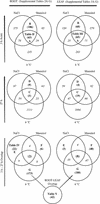Transcriptome changes for Arabidopsis in response to salt, osmotic, and cold stress
- PMID: 12481097
- PMCID: PMC166725
- DOI: 10.1104/pp.008532
Transcriptome changes for Arabidopsis in response to salt, osmotic, and cold stress
Abstract
To identify genes of potential importance to cold, salt, and drought tolerance, global expression profiling was performed on Arabidopsis plants subjected to stress treatments of 4 degrees C, 100 mM NaCl, or 200 mM mannitol, respectively. RNA samples were collected separately from leaves and roots after 3- and 27-h stress treatments. Profiling was conducted with a GeneChip microarray with probe sets for approximately 8,100 genes. Combined results from all three stresses identified 2,409 genes with a greater than 2-fold change over control. This suggests that about 30% of the transcriptome is sensitive to regulation by common stress conditions. The majority of changes were stimulus specific. At the 3-h time point, less than 5% (118 genes) of the changes were observed as shared by all three stress responses. By 27 h, the number of shared responses was reduced more than 10-fold (< 0.5%), consistent with a progression toward more stimulus-specific responses. Roots and leaves displayed very different changes. For example, less than 14% of the cold-specific changes were shared between root and leaves at both 3 and 27 h. The gene with the largest induction under all three stress treatments was At5g52310 (LTI/COR78), with induction levels in roots greater than 250-fold for cold, 40-fold for mannitol, and 57-fold for NaCl. A stress response was observed for 306 (68%) of the known circadian controlled genes, supporting the hypothesis that an important function of the circadian clock is to "anticipate" predictable stresses such as cold nights. Although these results identify hundreds of potentially important transcriptome changes, the biochemical functions of many stress-regulated genes remain unknown.
Figures


References
-
- Adamska I, Kloppstech K. Low temperature increases the abundance of early light-inducible transcript under light stress conditions. J Biol Chem. 1994;269:30221–30226. - PubMed
-
- Adamska I, Roobol-Boza M, Lindahl M, Andersson B. Isolation of pigment-binding early light-inducible proteins from pea. Eur J Biochem. 1999;260:453–460. - PubMed
-
- Allen GJ, Chu SP, Schumacher K, Shimazaki CT, Vafeados D, Kemper A, Hawke SD, Tallman G, Tsien RY, Harper JF et al. Alteration of stimulus-specific guard cell calcium oscillations and stomatal closing in Arabidopsis det3 mutant. Science. 2000;289:2338–2342. - PubMed
-
- Apse MP, Aharon GS, Snedden WA, Blumwald E. Salt tolerance conferred by overexpression of a vacuolar Na+/H+ antiport in Arabidopsis. Science. 1999;285:1256–1258. - PubMed
-
- Blumwald E. Sodium transport and salt tolerance in plants. Curr Opin Cell Biol. 2000;12:431–434. - PubMed
Publication types
MeSH terms
Substances
LinkOut - more resources
Full Text Sources
Other Literature Sources
Molecular Biology Databases

